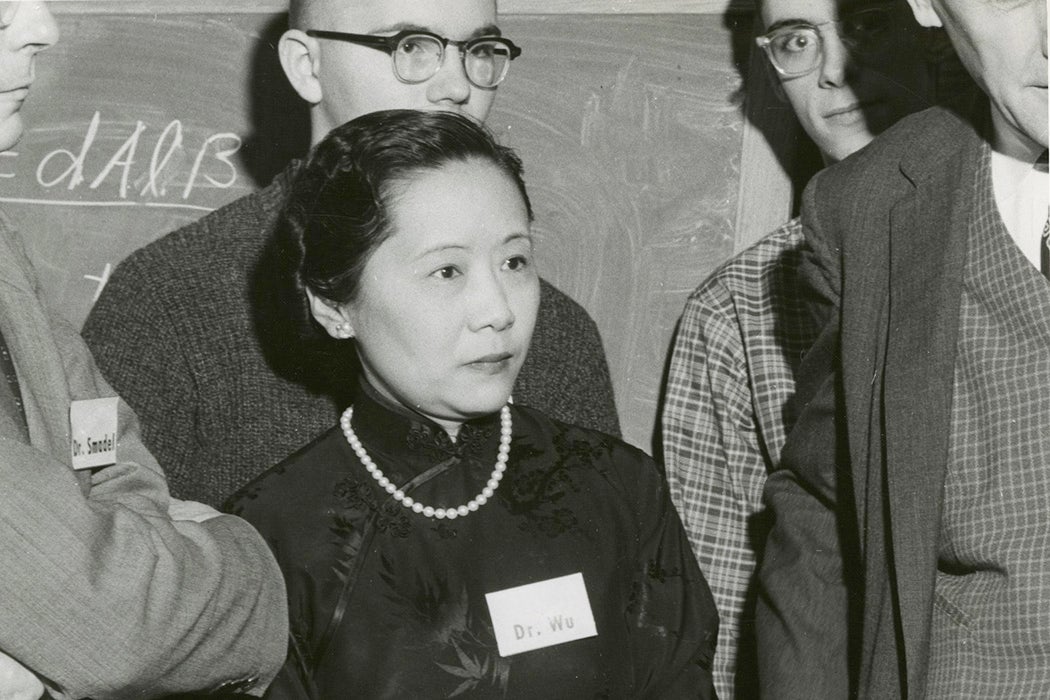Born near Shanghai in 1912, Chien-Shiung Wu boarded a ship to the United States in 1936 to study physics at the University of Michigan. She intended to get her PhD and then return home. Instead, while visiting a friend, she was persuaded to join the cutting-edge physics graduate program at the University of California, Berkeley.
Flash-forward to 1956, when an experiment of Wu’s demonstrated that a fundamental assumption of physics—the “conservation of parity”—was false. Two theoretical physicists, Tsung-Dao Lee and Chen-Ning Yang, had published a paper proposing the non-conservation of parity in weak nuclear forces, but it was Wu’s experiment that proved it. Lee and Yang received a Nobel Prize for the breakthrough in 1957. Wu was not included.
“Parity” is the theory that the laws of physics are symmetrical. They will occur regardless of specific directions like left or right, as these orientations supposedly don’t exist at a subatomic level. This means that all physical phenomena should be the same for a real object and its mirror image alike—if a physicist held a mirror to the universe, there would be no experimental way to distinguish between the original world and its inverted image.
Before 1956, “conservation of parity” was considered on par with other self-evident laws of nature, like gravity or the conservation of mass. Lee and Yang hypothesized that this wasn’t the case for weak nuclear forces. They published a list of experiments that could help prove it.
Wu took up the challenge. She would go on to perform “the first experiment to demonstrate, unambiguously and definitively, that [a] previously-held and fundamental assumption—that parity is conserved in ‘weak’ nuclear forces—was not valid,” explained her former student Leon Lidofsky in a 1997 talk honoring Wu’s research.
“One might suppose that every experimentalist who heard of these proposals was itching to go to work on them,” wrote physicist Freeman Dyson. “Here was the long-awaited chance to do a crucial experiment which would unambiguously reveal a new law of nature. But the experimentalists, with very few exceptions, calmly went on doing what they had been doing before.”
According to Dyson, only Wu, with collaborators at the National Bureau of Standards, “had the courage to spend six months in preparing the decisive experiment.” Wu wanted to find out if the beta decay of nuclei of cobalt-60 (a radioactive isotope of cobalt) emitted electrons in a symmetrical or an asymmetrical pattern.
No one in the physics community knew how significant this experiment would be. Dyson recalled: “I remember in October, 1956, I met Yang and said: ‘It will be exciting if this Wu experiment shows up something.’ ‘Yes,’ he said, ‘it will be exciting,’ and he went on to talk about his calculations in the theory of imperfect gases.”
Weekly Newsletter
Ultimately, Wu’s work showed that “electron emission had a preferred pathway based on the nuclear spin of the electron,” according to Lidofsky. The electrons that were emitted would have traveled in the same direction (left or right), even in a mirrored universe—violating the law of parity. Wu announced the results in January 1957.
Wu was known for her diligence and creativity, an “experimentalist whose experiments had the quality of aiming directly at the crux of the question,” remembered Lidofsky. Recently, she joined the ranks of legendary physicists like Albert Einstein, Enrico Fermi, and Maria Goeppert Mayer when the US Postal Service issued a new stamp with her portrait. “She was one of the premier physicists of her time,” said Lidofsky, “man or woman.” Overlooked for the Nobel, Wu’s work continues to influence the world of physics.
Support JSTOR Daily! Join our new membership program on Patreon today.







